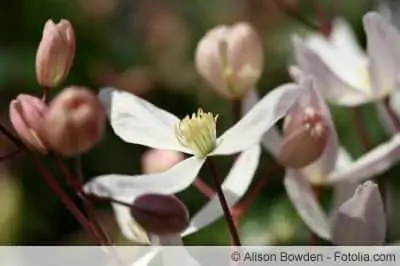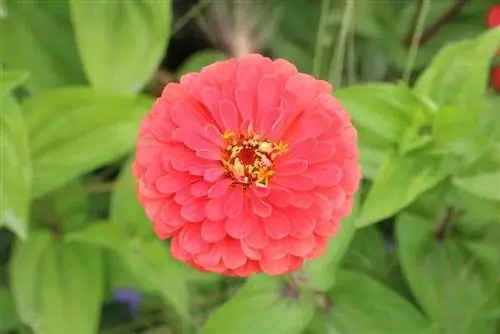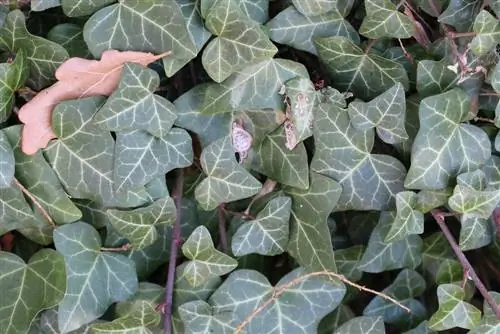- Author admin [email protected].
- Public 2023-12-17 03:39.
- Last modified 2025-06-01 06:48.
The Clematis armandii is the clematis that exudes the strongest scent of all clematis species. The flowers of the evergreen clematis grow in flower clusters on the delicate climbing plant for weeks. The buds form in early spring, and this clematis begins to open its flowers from the end of March (if the weather conditions are good). The Armand's clematis is an evergreen climbing plant with a vigorous growth that is also considered insensitive to the dreaded clematis wilt. Apart from a few special features that need to be taken into account when cultivating, the Clematis armandii requires little care.
Short profile
- Botanical name: Clematis armandii
- other names: evergreen clematis, evergreen clematis, Armand's clematis
- belongs to the buttercup family
- evergreen climbing plant
- woody with age
- Leaves: elongated lanceolate, conspicuously leathery
- Flowers: star-shaped or cup-shaped, white
- Flowering time: March to May
Occurrences
The Armand's clematis originally comes from northern Myanmar and China and was introduced to England in the 19th century by the plant collector Ernest Wilson after he discovered the plant in China. The genus Armandii is named after the missionary J. P. Armand David, who traveled through China to collect rare plants.
Location
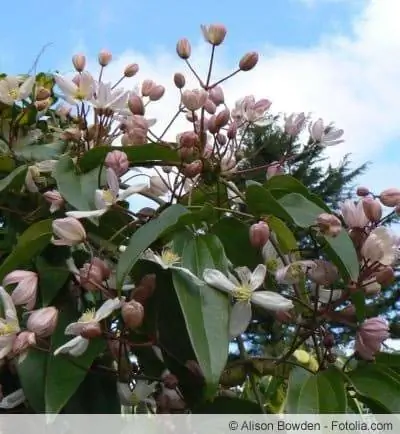
The evergreen clematis prefers a sunny location where it can easily climb to a height of three to five meters. It is the perfect plant to add fragrant accents to terraces, pergolas or even fences. The Clematis armandii thrives best on humus-rich soil, which can store water well but is not prone to waterlogging. It is also important that the location is well ventilated so that the leaves can dry quickly after a rainstorm. Cold, drafty areas must be avoided at all costs. It also doesn't hurt if the Armand's clematis is a little protected from the rain.
- Light requirement: sunny
- Southern locations are perfect
- preferably six hours of sun per day
- Soil: humus and nutrient-rich
- neutral or slightly alkaline
- permeable
- well ventilated without cold drafts
- evergreen in protected locations
Cool Roots
There is an important rule with clematis: the flowers want the sun, the roots need shade. In their natural habitat, the forest, the long shoots climb up from the shadows of the forest floor into the light. There are many horticultural or decorative options to provide Clematis armandii with these conditions. At the feet of the clematis, for example, the bleeding heart, a rose, purple bells or even the columbine can create beautiful accents and at the same time shade the roots. Alternatively, stones are also suitable for protecting the roots from heat. The plant should be shaded up to a height of about 40 centimeters above the ground.
Plants
The best time to plant Clematis armandii is late summer or early autumn. This means that the distinctive climbing plant still has enough heat in the soil to grow well. Only a well-established clematis survives the frosts in winter without damage. It is advisable to buy the evergreen clematis with a larger root ball. These larger and older plants grow better and are less sensitive than those in standard 10cm pots. Larger specimens are comparatively expensive, but the investment is worth it. If there are very vigorous perennials or shrubs in the neighborhood, a root barrier is necessary to protect the roots of the Armand's clematis.
- Planting time: Spring to August
- possibly install a trellis in advance
- Prepare the floor
- mix very acidic soils with a little lime
- alternatively use wood ash
- Loosen the soil well on an area of 50 x 50 cm
- mix heavy soils with sand and mature compost
- possibly create drainage made of gravel or sand
- add humus or compost to sandy or poor soils
- Planting hole: at least twice the ball size and depth
- Planting depth: deeper than in the pot
- the first pair of leaves (or eyes) must be just below ground level
- Plant slightly at an angle towards the climbing aid
- - Pond liner is suitable as root protection
- Alternatively, a large flower pot (without bottom) can also be used
- Fill the planting hole with humus or compost
- watering should be done weekly during the first few weeks
Tip:
Always be very careful when pulling the clematis from its pot and planting it. The shoots break off very easily.
Climbing aid
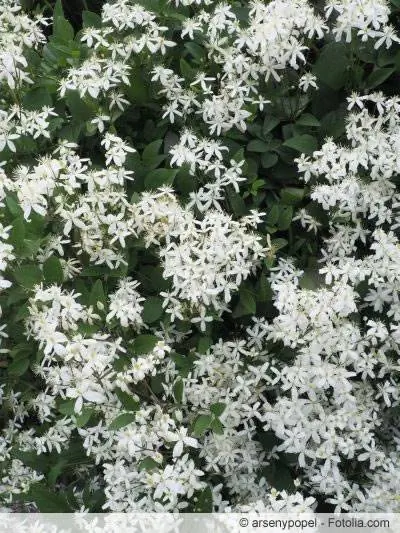
The evergreen clematis forms leaf tendrils for climbing that wind around suitable rootstock like beans. Therefore, a climbing aid is usually necessary for the plant. In a good location, the plant will later climb independently without any problems. However, if the young shoots of the clematis find nothing to twine around, they stop growing. Even thin cords are enough for the shoots to hold on. However, thick rods are just as unsuitable as obelisks or other smooth surfaces. The thickness of the struts is important for climbing. These may have a maximum diameter of one centimeter so that the leaf tendrils can still hold on.
- Wire cords
- Fishing lines
- thin branches
- chain link fence
- Trellis
Tip:
For trellises that have struts that are very far apart, auxiliary struts must be pulled in. Twine or fishing lines are perfect for this.
Pouring
All clematis species are thirsty plants, so they require regular watering. They should not dry out significantly during flowering and through the summer. Newly planted clematis must be watered at least once a week in the first few weeks so that the plants grow in well. To better retain moisture in the soil, it is recommended to mulch the soil. However, the mulch should be some distance away from the shoots that grow from the ground. A radius of about 10 cm is sufficient.
Fertilize
Freshly planted evergreen clematis do not need any additional fertilizer in the first year after planting, as long as they have been provided with a good portion of compost. From the second year onwards, some compost or long-term fertilizer such as horn meal or horn shavings should be worked into the soil in spring. Purely organic fertilizer provides nutrients for the Armand's clematis over a period of about six months. Therefore, fertilizing once in spring is sufficient. If you use conventional flower fertilizers, you should make sure when purchasing that the fertilizer has a low nitrogen content (for example NPK of 5/10/10). Fertilization is carried out monthly according to the instructions. From August onwards, fertilization will be stopped until next spring.
Cutting
In order to keep the Armands Clematis strong and vital for years, occasional checking of the plant is necessary. If injured, sick and wilted shoots are identified and removed early, the risk of illness is reduced. Cutting is always done on a warm, cloudy but dry day so that the wounds can dry quickly. The Clematis armandii forms its flower buds the previous year and blooms on annual shoots. That's why it is not cut in autumn, but directly after flowering, so as not to unnecessarily diminish its splendor. The aim of the cut is, on the one hand, to limit the growth height of the clematis and, on the other hand, to remove tendrils that have become lazy to bloom in order to create space for strong young shoots.
- Prune young plants carefully so that they branch out more
- Clematis planted in the previous year: cut back in spring to above the first pair of he althy buds
- older plants need a little more pruning
- cut very tall plants back to about 2 meters
- shorten medium-sized plants by about 1/3
- shorten long, unbranched shoots by 2/3
- cut an old shoot close to the ground every three to four years
- this promotes the sprouting of young, vital shoots
Propagate
The evergreen clematis can be propagated both by seeds and by cuttings and cuttings.
Seeds
Since the seeds do not germinate for long, they should be sown as early as possible. Some hybrids do not produce seeds or only produce unsightly, weak young plants. It's still worth a try.
- Substrate: cactus soil or growing soil
- moisten slightly
- Place 1 to 3 seeds per pot
- press lightly
- cover with a fine layer of sand
- Set up warm and bright (no direct sun)
- cover with glass pane or plastic bag
- ventilate occasionally
- remove the bag after germination
- Prick out into individual pots from the moment the first pair of leaves form
Cuttings
The best time to take cuttings is between April and June. He althy, strong shoots that are already woody are cut.
- Length: about 10 to 15 cm
- Substrate: cactus soil or growing soil
- remove lower leaves
- Scrape off the bark at the bottom to about 2 cm
- stick in moist substrate
- Cut off the shoot tip (ensures better branching)
- place brightly (without direct sun)
- Always keep the substrate slightly moist
Lowers
The Armand's clematis can also be easily propagated using planters. With this method there is little risk of the cutting dying as it remains on the mother plant for the time being.
- Time: Spring to early summer
- choose strong, soft shoots
- detach from the climbing aid
- remove lower leaves
- Bend shoot downwards
- steer at ground level in pot with moist potting soil
- Just bury the shoot shallowly
- fix with stone or metal hook
- Support the end of the derived shoot with a stick
- always keep slightly moist
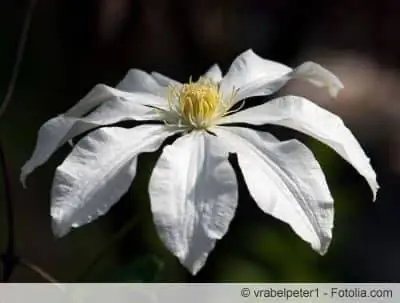
It is best to leave the offshoot on the mother plant until next spring. The pot is simply sunk into the ground and well protected from frost with brushwood. In spring, carefully remove the ball of the offshoot from the pot and check whether it is well rooted. If this is the case, it can be separated from the mother plant and planted in a flower pot with a humus-rich substrate. Otherwise it just stays on the mother plant a little longer.
Wintering
The clematis from the Armandii group are particularly characterized by the fact that they are better frost-resistant than other evergreen clematis species. Nevertheless, a location protected from the wind and additional protection for the cold season are recommended. Since the evergreen clematis retains its leaves even in winter, it is very important that the plant has enough light and that it is watered in dry times.
- Line the floor with brushwood
- alternatively place a few large stones on the ground (store the heat)
Special varieties
Unlike some other clematis varieties, the flower of Clematis armandii is very simple and still looks like a wildflower. All varieties of evergreen clematis are very delicate and therefore appear romantic. There are a large number of varieties, but they are primarily used in Chinese medicine. The following are suitable for gardening:
- 'Apple Blossom': the white, star-shaped flower (4-6 cm) has a delicate pink tint
- 'Hendersonii Rubra': light pink flowers
- 'Little White Charm': pure white flower (4-5 cm) with long, very narrow petals, for mild locations, hardy down to -5 degrees
- ‘Snowdrift’: slightly wider petals, hardy down to -12 degrees
Diseases
The Clematis armandii is not particularly susceptible to clematis wilt, but it can still occur. A distinction is made between two fungal diseases of clematis wilt:
Phoma Clematis Wilt
It can be recognized by discoloration on the underside of the leaves. Locations where air cannot circulate make clematis vulnerable. Therefore, the evergreen clematis should be planted somewhat protected from rain but well ventilated. Occasional thinning of the shoots provides additional ventilation. At the first symptoms, affected plant parts should be cut off and disposed of with household waste.
Fusarium Clematis Wilt
The fungus penetrates through injuries to the shoots and seriously damages the plant inside. Fusarium wilt is very dangerous for clematis because not even fungicides help. Therefore, infected plants must be cut off close to the ground as early as possible before the fungus gets to the lower parts of the plant. Planting slightly deeper as well as regular watering and fertilization reduce the risk of the plant becoming ill or dying if infected.
Conclusion
The Clematis armandii is a wonderful climbing plant that integrates wonderfully into any garden with its simple, white flowers. Apart from a protected location, they don't make any major demands and don't require much work. They look particularly beautiful together with pink bush roses, which underline the simple elegance of the clematis.

